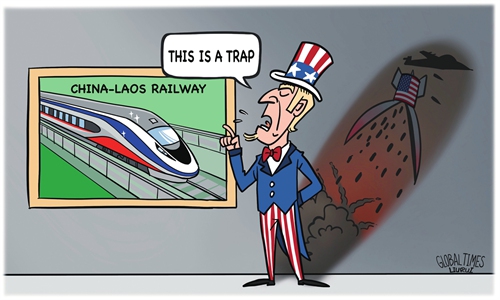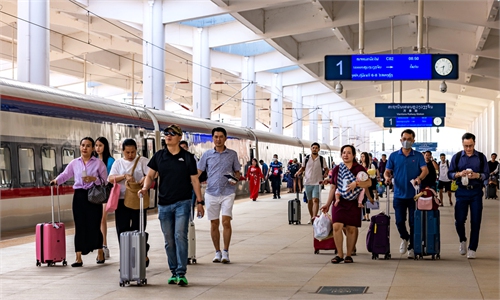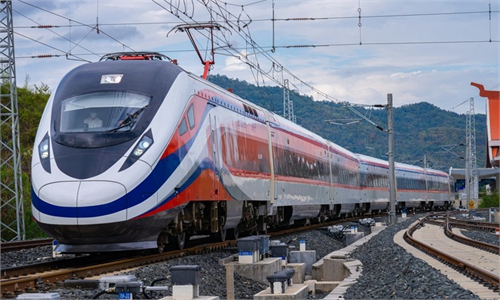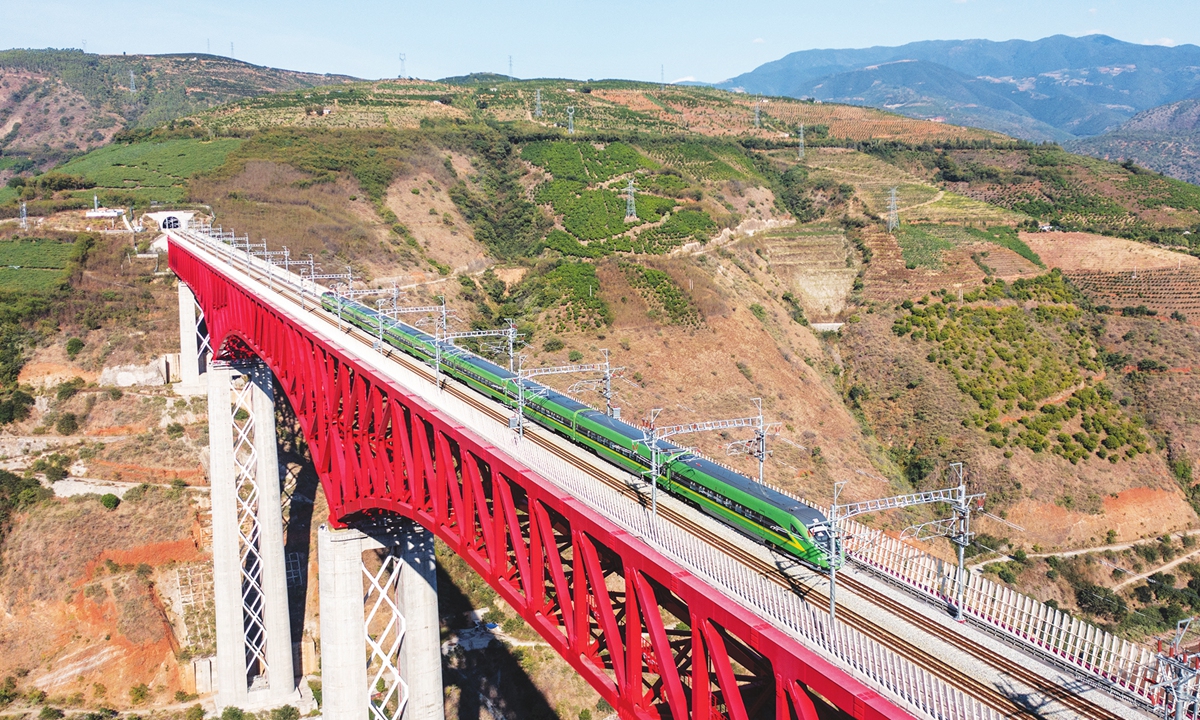
The Fuxing train passes the Yuanjiang Bridge on the China-Laos railway in southwest China's Yunnan Province on November 23, 2022. Photo: Xinhua
Editor's Note:This year marks the 10th anniversary of the Belt and Road Initiative (BRI) proposed by Chinese President Xi Jinping. Through the lens of foreign pundits, we take a look at 10 years of the BRI - how it achieves win-win cooperation between China and participating countries of the BRI and how it has given the people of these countries a sense of fulfillment.
In an exclusive interview with Global Times (GT) special correspondent Sun Guangyong, Lao Prime Minister Sonexay Siphandone (Sonexay) stated that the China-Laos BRI cooperation has become a successful example of countries and regions participating in the initiative.
This is the 17th piece of the series.
GT: What impact has the BRI cooperation between China and Laos had on the economic and social development of Laos? How do you see China's current role in international affairs through this initiative?
Sonexay: The BRI cooperation framework has made significant contributions to promoting the social and economic development, job creation and poverty reduction of countries and regions participating in the BRI. Laos has supported and participated in the BRI from the beginning, actively engaging in various cooperation mechanisms under the initiative, such as digitalization, energy cooperation and green development cooperation. In addition, both Laos and China attach great importance to the construction projects of the Laos-China economic corridor within the BRI cooperation framework, including the Vientiane Saysettha Comprehensive Development Zone, the China-Laos expressway, and hydropower stations. These projects have become important driving forces for Laos' economy, maintaining its continued growth momentum.
Looking back, China has actively promoted BRI cooperation, demonstrating active and extensive engagement on regional and international stages. Particularly, it has focused on strengthening cooperation with various countries and accelerating BRI cooperation according to the plan, gradually carrying out mutually beneficial cooperation. At the same time, the BRI aims to develop cooperation in areas such as infrastructure, trade, investment and culture in order to enhance China's role in global trade and investment.
GT: How do you see the development of China-Laos relations in the coming years? How do you see the significance of China and Laos firmly supporting each other in pursuing development paths that suit their own national conditions?
Sonexay: Laos and China are neighboring countries connected by mountains and rivers, and the friendship between the two countries has a long history. In recent years, the bilateral relationship has entered an unprecedented new stage. Various departments and levels of Laos and China have frequent exchanges, and fruitful practical cooperation has been achieved in various fields. The Laos-China Railway and highways have transformed the landscape of Laos, and cooperation in power grids and finance continues to expand. Laos will continue to deepen comprehensive strategic cooperation with China and always stay at the forefront of high-quality BRI construction.
Currently, the regional and international situation is facing various international challenges such as economic and financial crises, natural disasters, disease outbreaks, transnational crimes and conflicts, which all have a serious impact on the economies of the region and the world. Therefore, the cooperation between the parties, governments, and peoples of Laos and China will continue to strengthen and deepen with mutual exchanges, support and assistance. The two countries should uphold the spirit of being "good neighbors, good friends, good comrades and good partners," and continue to support each other on the international and regional stages, and make important contributions to the peaceful and stable development of the international and regional areas.
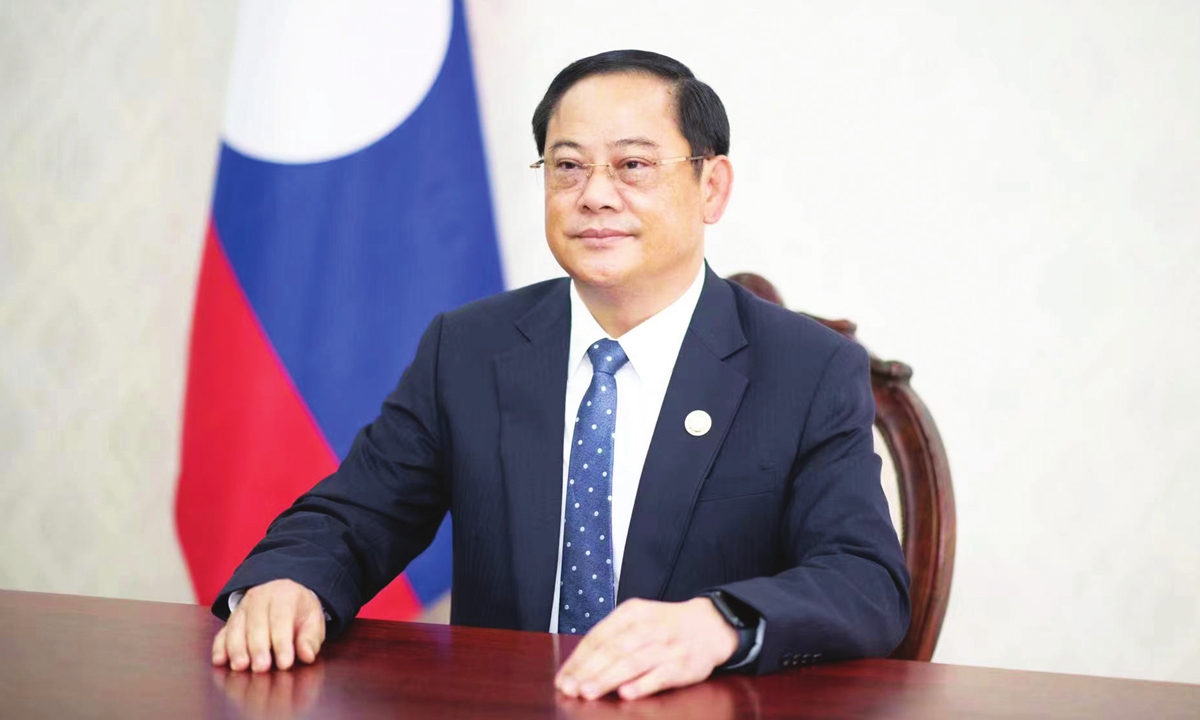
Sonexay Siphandone Photo: Sun Guangyong/GT
GT: Have you personally ever ridden on the China-Laos Railway? What are your expectations for this landmark project of the China-Laos BRI cooperation?Sonexay: The Laos-China Railway under the BRI is an important strategic project that promotes the economic and social development of Laos. The Laos-China Railway connects Laos, China, and the local region and the world, creating a favorable and conducive environment for trade, investment, tourism and cross-border transportation of goods and contributing to job creation. For the people of Laos, it not only promotes the development of the regions along the railway but also contributes to the overall economic growth of the country.
I have visited all the stations of the Laos-China Railway. During my tenure as deputy prime minister, I was responsible for national economic affairs, including the construction of the Laos-China Railway. Since the official operation of the Laos-China Railway on December 3, 2021, and the opening of international passenger trains on April 13, 2023, I have traveled on the high-speed trains of the Laos-China Railway multiple times, which are very comfortable, fast and smooth.
The success of the Laos-China Railway instills the people of Laos with a deep sense of pride and achievement. The Laos-China Railway is a flagship project of the BRI and has become a symbol and model for implementing the BRI, helping Laos transform from a landlocked country to a strong nation. The connection between Laos and the region, including the creation of a favorable environment for trade, development, tourism and transportation of goods through the railway, has made a significant contribution to job creation and travel for the people of Laos. The Laos-China Railway is an important link between China and Laos, and in the future, we hope to connect it with railways in several Southeast Asian countries. We hope that the Laos-China Railway will become the most important project to promote regional development and integration, especially in reducing poverty and promoting sustainable development in the future.
GT: China will soon host the Third Belt and Road Forum for International Cooperation. What do you expect from this forum?
Sonexay: Laos has actively supported and participated in the BRI from the very beginning. The president of Laos has led high-level delegations to attend the previous two Belt and Road Forums for International Cooperation. This year, Laos will continue to send a high-level delegation to attend the third forum. The main theme of this forum is "High quality Belt and Road Cooperation: Together for Common Development and Prosperity." It will focus on topics such as connectivity in an open-world economy, the green Silk Road, and the digital economy as new growth drivers. I believe that each topic aligns with the current global environment, where countries are concentrating their efforts on economic recovery and addressing various challenges, including economic difficulties, financial issues and climate change.
As a partner under the BRI cooperation framework, Laos hopes that the outcomes of this meeting will promote and strengthen bilateral and multilateral cooperation between Laos and China, overcome various difficulties and challenges, and move toward sustainable development, becoming an important milestone in building a global community of shared future.
GT: For some time now, some politicians in the US and other Western countries have been saying that the BRI has brought the so-called "debt trap" to developing countries. Given Laos' participation in the BRI, what is your response to this argument?
Sonexay: The BRI has not brought a "debt trap" to developing countries. To the contrary, it has promoted the economic and social development of participating countries. The so-called debt trap claim is baseless.
Laos, with a low level of development, and as a landlocked country with no access to the sea, it faces limitations in terms of convenient transportation, trade investment and attracting funds to drive economic and social development, especially in the development of infrastructure that requires substantial budgets. Therefore, Laos has planned a development strategy that focuses on sub-regional and regional connectivity, participating in various sub-regional, regional and international cooperation with Mekong countries, ASEAN and the China-proposed BRI to attract cooperation and funding from friendly countries for its own development. The Laos-China Railway is one of the projects under the BRI that helps Laos build a Southeast Asian land transportation network and an Asian regional railway network. It benefits not only Laos but also neighboring countries and regions.
Regarding debt, it can be seen that governments in developing countries like Laos must conduct thorough research and planning before implementing development projects that require borrowing. They should also pay attention to debt management and implement measures that do not hinder economic development. The social and economic development of developing countries requires a huge budget. This budget needs to be raised with the support of friendly countries, international financial institutions, countries offering aid and through bilateral and multilateral channels. The result will be the improvement of people's living conditions and stable economic growth.
GT: You have visited China many times and played a very important role in promoting China-Laos relations. What impressed you most during your visits? What opportunities will the Chinese-style modernization bring to the development of China-Laos relations?
Sonexay: Every time I visit and work in China, I can see its rapid development and growth. Whenever I visit cities like Nanning, Beijing and Guangzhou, after a certain period of time, many places become unrecognizable. This indicates that construction and infrastructure development in various parts of China have made significant progress, and for urban development this is truly inspiring.
One particularly impressive experience that the world can learn from China is its ability to find fast, smooth and effective solutions to problems. For example, in response to the COVID-19 pandemic, China promptly and efficiently handled the situation, leading to a rapid recovery of the national economy. Additionally, China has successfully addressed poverty issues among its people through targeted policies, lifting nearly 100 million rural poor out of poverty in a short period of time. This achievement is a remarkable milestone in Chinese history and a valuable experience that developing countries, including Laos, hope to learn from.
Regarding future cooperation, the Lao People's Revolutionary Party and Laos government will continue to closely collaborate with the Communist Party of China and Chinese government, strengthening friendly relations at all levels and in all fields. The two countries share a brotherly cooperation foundation based on their common socialist ideals. The two parties, governments, and relevant departments and institutions will continue to enhance mutual exchanges and governance experiences, consolidate and deepen cooperation in security and defense, strengthen practical cooperation in trade and investment, and promote more frequent and broader exchanges to deepen and implement various forms of cooperation. This will contribute to the further development of the Laos-China relationship and the deepening of the construction of a community with a shared future between China and Laos.
GT: Last December, China and Laos issued a joint statement on further deepening the building of a China-Laos community with a shared future. How do you view the achievements and significance of the two sides' efforts in building a China-Laos community with a shared future?
Sonexay: China and Laos are not only comprehensive strategic partners of cooperation with high mutual trust, assistance and mutual benefit but also an unbreakable community of shared destiny. I highly appreciate the successful cooperation between China and Laos in deepening the comprehensive strategic partnership, which is the right decision to deepen the cooperation between the two countries. China and Laos have been friendly since ancient times, and deep mutual trust has been established between the parties, state leaderships and the peoples of both countries. Especially in recent years, China-Laos relations have continued to develop, from political and security cooperation to economic, trade, cultural and social cooperation. Cooperation in all aspects has continuously deepened and expanded, bringing tangible benefits to the peoples of China and Laos.
